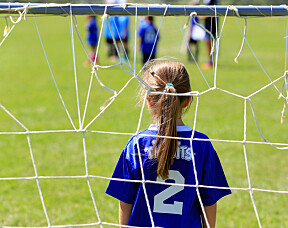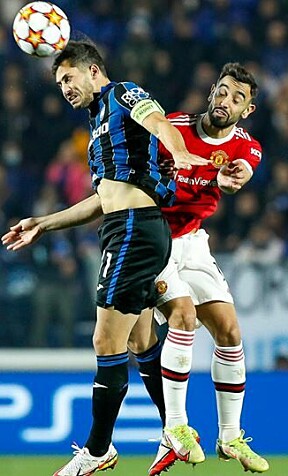
Football: How dangerous is heading the ball?
Research shows that dementia is more common among former professional football players. Several countries have introduced bans on heading for young football players. More research is now being conducted on this topic in Norway.
Repeated blows to the head can, in the worst case, cause brain injuries.
In a study from 2019, researchers examined the prevalence of neurodegenerative disease among over 7,000 Scottish ex-football players in the top league.
They had three times the risk of dying from dementia compared to the control group.
In a recent study from the Karolinska Institute in Sweden, researchers investigated 6,000 men who played football in the Swedish top league, Allsvenskan, between 1924 and 2019.
They also had a higher risk of dementia.
The Scottish study is still ongoing, and in 2021, researchers showed that the risk varies depending on the position played on the pitch.
The risk of dementia was higher among defenders.
Ban on heading for children
Several countries have now banned heading the ball for young footballers.
In Sweden, football players under the age of 13 are not recommended to practice headers.
How dangerous is it to head the ball?
Sciencenorway.no has asked two researchers at the Department of Sports Medicine at the Norwegian School of Sport Sciences.

Following the latest guidelines
Thor Einar Gjerstad Andersen is a sports physician and professor of sports medicine at the Department of Sports Medicine.
Andersen is also responsible for medical matters at the Norwegian Football Federation.
He provides information on how to prevent injuries from heading.
“In Norway, the Football Federation follows UEFA's latest guidelines regarding heading in children's and youth football,” Andersen says.
Children use lighter balls
Footballs come in various sizes: 3, 4, and 5.
Children between the ages of six and nine use lightweight balls, while those aged 10 to 14 use smaller size 4 balls, which are also lighter and smaller than the balls used in adult football.
The use of lighter balls reduces the impact on the head when girls and boys head the ball, Andersen explains.
He is also the medical director at the Idrettens helsesenter (Sports Health Centre).
It is better to train heading than to ban it
The number of heading training sessions should also be limited. At the same time, it is essential for children to learn how to head the ball because heading is an integral part of football and occurs in matches, Andersen argues.
“Then it also becomes crucial to head with the correct technique, which is to use the forehead and tighten the neck muscles,” he explains.
This is confirmed by Henrik Zetterberg, a professor of neurology at the University of Gothenburg:
“Controlled headers do not seem to cause any injuries. However, if you fail to tighten the neck, you can get rotational injuries,” he tells forskning.se (link in Swedish).
Concerned parents
The dangers of heading are widely discussed in football associations worldwide, Andersen says.
“Parent groups and mother associations are sceptical about allowing children to head the ball, especially in the USA, where soccer is relatively new,” he says.
The possibility of imposing a ban has been discussed, but UEFA and FIFA’s conclusion has been to limit the number of headers for children and youth.
“The most important thing is to raise awareness that head injuries, including concussions, must be taken seriously and managed according to current international guidelines,” Andersen says.
The Norwegian Football Federation is part of an application for an Erasmus scholarship together with UEFA, Croatia, Germany, and Turkey.
“The goal is to provide customised information to parents, physiotherapists, coaches, and players on how to detect and manage head injuries in children's and youth football,” he says.
Can't establish causation
Although research has shown that athletes in contact sports with repeated blows to the head are more likely to develop dementia, the causes may be complex.
It is difficult to establish a causal relationship, both legally and scientifically.
Most studies are based on either animal experiments or retrospective studies, meaning that the athletes are examined after they have stopped playing the sport.
Other factors may have played a role
The studies conducted so far have focused on football players who were professionals in the 50s, 60s, and 70s.
“At that time, heavier and harder balls were used than those used now,” Andersen says.
Additionally, researchers do not know exactly what caused the head injuries. It is likely that concussions or other head injuries have been just as dangerous as headings.
“We also know little about other risk factors for dementia in these players' lives. If, for example, the former football players consumed more alcohol than average, it may have been a contributing factor to the development of dementia,” Sara Dahlén says.
She is a neurologist and PhD candidate.
Less awareness
There may also have been less awareness of head injuries several decades ago. Players who collided with another player and suffered a concussion were rarely taken off the pitch.
Back then, getting hit on the head was considered a part of football. As long as you didn't lose consciousness, it was not considered serious, Dahlén says.
Today we know that only 10 per cent of those who suffer a concussion lose consciousness.
Dahlén is currently researching the brain health of female, former, and current top football players. This research will contribute to her doctorate at the Department of Sports Medicine.
Leads to long-term absence
There are, in fact, more questions than answers regarding head injuries, heading, and the risk of long-term injuries.
But one thing we already know: Head injuries in football lead to a high burden of injury, Andersen asserts.
"Head injuries rarely occur, but when they do, they can result in prolonged absence for the player," he says.
Often, the absence is longer compared to fractures in other parts of the body.
This is evident from an ongoing study in Toppserien, the top level of women's association football in Norway.
Knee injuries are the most common in football and result in the greatest burden of injury, followed by muscle injuries. Head injuries rank third.
Investigating female football players
Sara Dahlén is set to examine female top football players who were active in the 1990s and their possible head injuries.
"So far, female football players and potential long-term consequences of head injuries and heading have not been studied," Dahlén explains.

One reason is that football is a relatively young sport for women. It was not until the 1970s that women's football was accepted.
“That’s why it's only now that former top players are starting to reach an age where the long-term consequences of head injuries can become apparent,” Dahlén says.
Blood tests and brain scans
Women who have played in Toppserien and on the national team in the 1990s will fill out a comprehensive questionnaire about their football career. This includes information about head injuries, frequency of headers, and medical and social history.
They will undergo neurocognitive testing and an MRI of the brain to assess brain function and possible signs of neurodegenerative changes (see fact box).
They will also have blood samples taken to look for markers of changes.
Dahlén will, among other things, examine whether women have more symptoms after head injuries than men.
The control group will consist of athletes in sports that do not have a high risk of repeated head trauma, such as running, cross-country skiing, and orienteering.
"We hope that former football players and other athletes find the project important and interesting. More participants ensure better study results," Dahlén says.
———
Translated by Alette Bjordal Gjellesvik.
Read the Norwegian version of this article on forskning.no
References:
Mackay et al. Neurodegenerative Disease Mortality among Former Professional Soccer Players, New England Journal of Medicine, 2019. DOI: 10.1056/NEJMoa1908483
Russell et al. Association of Field Position and Career Length With Risk of Neurodegenerative Disease in Male Former Professional Soccer Players, JAMA Neurology, 2021. DOI: 10.1001/jamaneurol.2021.2403





































